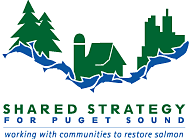|
(From North West Indian Fisheries Commission) EATONVILLE, WA—Engineered logjams on the Mashel River are leading to more salmon and a natural increase of their habitat. Two years ago logjams were constructed along a one mile stretch of the Mashel by the Nisqually Tribe and the South Puget Sound Salmon Enhancement Group. “While the initial restoration work added some habitat to what had been a river lacking many habitat features, nature has been building on our work,” said Jeanette Dorner, salmon recovery manager for the Nisqually Tribe. The logjams create more habitat by capturing fallen trees that would have otherwise floated down river. Logjams create deep pools in which adult salmon can rest in while making their way upstream. They also provide shelter and food for juvenile salmon migrating out to sea. Past logging has starved the Mashel of riverside trees necessary for logjams to form naturally. “By building logjams, we have jump started the process of habitat creation on the Mashel,” said Dorner. Coho, a species struggling in the Nisqually watershed, have especially benefited from the increased rearing habitat on the Mashel. “Because coho spend an extra year in freshwater when they’re young, they depend on freshwater habitat more than other species of salmon,” said Dorner. “An increase in freshwater habitat will benefit all species of salmon, but especially coho.” The restoration project is also providing additional protection for chinook salmon, which are listed under the federal Endangered Species Act. “The Mashel River is one of only two tributaries in the watershed that Chinook use to spawn,” said Dorner. “By increasing habitat overall, we’re lessening the chance that a single disaster, like a landslide in the Nisqually River, could wipe out the population.” The habitat restoration work in the lower river will be complemented by additional restoration work to be done this summer in the upper Mashel River. The tribe and the enhancement group will restore a stretch of the Mashel that flows through a popular park in Eatonville. A rip-rap levee will be removed and replaced with a series of logjams. “The Mashel River is an example that in-stream habitat restoration works and benefits salmon,” said Dorner. “Habitat restoration and protection are the most important things we can do to recover struggling salmon stocks.” For more information, contact:
Jeanette Dorner, salmon recovery manager, Nisqually Indian Tribe,
(360) 438-8687. Emmett O’Connell, South Sound information officer,
NWIFC, (360) 438-8687. |
||||||||||||||||||||

 Habitat Restoration
on Mashel River Showing Results
Habitat Restoration
on Mashel River Showing Results